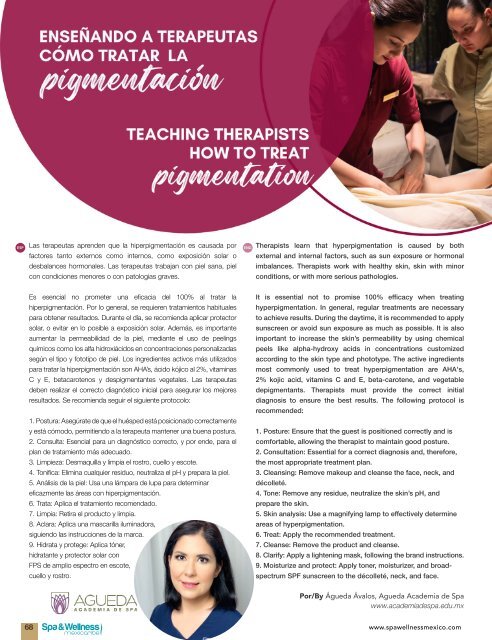Spa & Wellness MexiCaribe 53, Spring 2024
For Spa & Wellness Enthusiasts and Industry Professionals alike. Providing up to date information on global & national spa trends, news & events, products & services, new launches, Spa experiences, networking opportunities and the growing community of spa in an expanding industry. We believe in bringing together the spa community. Read our online articles and magazine, answer poll questions, find suppliers and events, browse recruitment listings, add pictures to our gallery, follow our blog and join us on Facebook, Twitter and LinkedIn and become a part of the Spa Community in Mexico, the Caribbean and Latin America.
For Spa & Wellness Enthusiasts and Industry Professionals alike. Providing up to date information on global & national spa trends, news & events, products & services, new launches, Spa experiences, networking opportunities and the growing community of spa in an expanding industry. We believe in bringing together the spa community. Read our online articles and magazine, answer poll questions, find suppliers and events, browse recruitment listings, add pictures to our gallery, follow our blog and join us on Facebook, Twitter and LinkedIn and become a part of the Spa Community in Mexico, the Caribbean and Latin America.
You also want an ePaper? Increase the reach of your titles
YUMPU automatically turns print PDFs into web optimized ePapers that Google loves.
ESP<br />
Las terapeutas aprenden que la hiperpigmentación es causada por<br />
factores tanto externos como internos, como exposición solar o<br />
desbalances hormonales. Las terapeutas trabajan con piel sana, piel<br />
con condiciones menores o con patologías graves.<br />
ENG<br />
Therapists learn that hyperpigmentation is caused by both<br />
external and internal factors, such as sun exposure or hormonal<br />
imbalances. Therapists work with healthy skin, skin with minor<br />
conditions, or with more serious pathologies.<br />
Es esencial no prometer una eficacia del 100% al tratar la<br />
hiperpigmentación. Por lo general, se requieren tratamientos habituales<br />
para obtener resultados. Durante el día, se recomienda aplicar protector<br />
solar, o evitar en lo posible a exposición solar. Además, es importante<br />
aumentar la permeabilidad de la piel, mediante el uso de peelings<br />
químicos como los alfa hidroxiácidos en concentraciones personalizadas<br />
según el tipo y fototipo de piel. Los ingredientes activos más utilizados<br />
para tratar la hiperpigmentación son AHA’s, ácido kójico al 2%, vitaminas<br />
C y E, betacarotenos y despigmentantes vegetales. Las terapeutas<br />
deben realizar el correcto diagnóstico inicial para asegurar los mejores<br />
resultados. Se recomienda seguir el siguiente protocolo:<br />
1. Postura: Asegúrate de que el huésped está posicionado correctamente<br />
y está cómodo, permitiendo a la terapeuta mantener una buena postura.<br />
2. Consulta: Esencial para un diagnóstico correcto, y por ende, para el<br />
plan de tratamiento más adecuado.<br />
3. Limpieza: Desmaquilla y limpia el rostro, cuello y escote.<br />
4. Tonifica: Elimina cualquier residuo, neutraliza el pH y prepara la piel.<br />
5. Análisis de la piel: Usa una lámpara de lupa para determinar<br />
eficazmente las áreas con hiperpigmentación.<br />
6. Trata: Aplica el tratamiento recomendado.<br />
7. Limpia: Retira el producto y limpia.<br />
8. Aclara: Aplica una mascarilla iluminadora,<br />
siguiendo las instrucciones de la marca.<br />
9. Hidrata y protege: Aplica tóner,<br />
hidratante y protector solar con<br />
FPS de amplio espectro en escote,<br />
cuello y rostro.<br />
It is essential not to promise 100% efficacy when treating<br />
hyperpigmentation. In general, regular treatments are necessary<br />
to achieve results. During the daytime, it is recommended to apply<br />
sunscreen or avoid sun exposure as much as possible. It is also<br />
important to increase the skin’s permeability by using chemical<br />
peels like alpha-hydroxy acids in concentrations customized<br />
according to the skin type and phototype. The active ingredients<br />
most commonly used to treat hyperpigmentation are AHA's,<br />
2% kojic acid, vitamins C and E, beta-carotene, and vegetable<br />
depigmentants. Therapists must provide the correct initial<br />
diagnosis to ensure the best results. The following protocol is<br />
recommended:<br />
1. Posture: Ensure that the guest is positioned correctly and is<br />
comfortable, allowing the therapist to maintain good posture.<br />
2. Consultation: Essential for a correct diagnosis and, therefore,<br />
the most appropriate treatment plan.<br />
3. Cleansing: Remove makeup and cleanse the face, neck, and<br />
décolleté.<br />
4. Tone: Remove any residue, neutralize the skin’s pH, and<br />
prepare the skin.<br />
5. Skin analysis: Use a magnifying lamp to effectively determine<br />
areas of hyperpigmentation.<br />
6. Treat: Apply the recommended treatment.<br />
7. Cleanse: Remove the product and cleanse.<br />
8. Clarify: Apply a lightening mask, following the brand instructions.<br />
9. Moisturize and protect: Apply toner, moisturizer, and broadspectrum<br />
SPF sunscreen to the décolleté, neck, and face.<br />
Por/By Águeda Ávalos, Agueda Academia de <strong>Spa</strong><br />
www.academiadespa.edu.mx<br />
68<br />
www.spawellnessmexico.com















